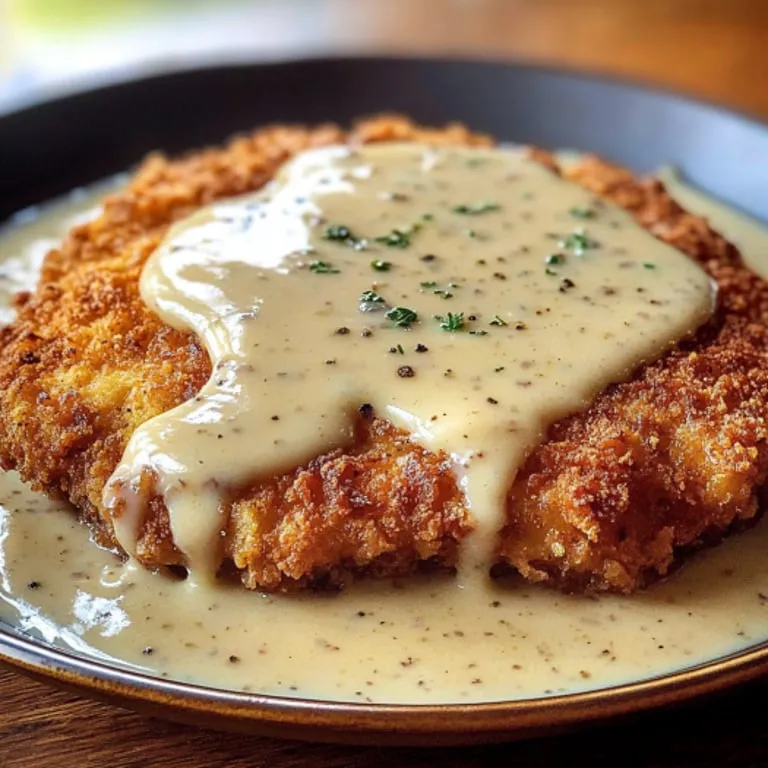 Save
Save
The first time I bit into this crispy buttermilk chicken fried steak, I was instantly transported to my grandmother's kitchen, where the air was always filled with the smell of frying meat and simmering gravy. The tender cube steak, enveloped in a perfectly seasoned, golden crust, soaked up the warm, country-style gravy in a way that felt like a hug from the inside out. It became my go-to comfort dish, a little ritual of indulgence and nostalgia that never disappoints.
I stumbled upon the buttermilk soak trick years ago, trying to rescue a tough cube steak. The acidity tenderized the meat beautifully, and the flavors in the seasoned flour step created a crust so satisfying I never looked back. It just felt like the right balance between crispy and cozy.
Essential Ingredients
- Cube steaks (1 cm thick): tender yet sturdy, perfect for pounding thinner. Look for uniform thickness and minimal marbling.
- Buttermilk: the star tenderizer, it adds a tangy note that cuts through the richness and helps the coating stick. Opt for fresh buttermilk with a creamy texture.
- Eggs: bind the coating layers, creating that irresistible crust. Fresh large eggs work best.
- All-purpose flour: the base for the crispy crust and gravy roux; sift beforehand to avoid lumps.
- Seasonings: paprika, garlic powder, onion powder: these layers of flavor amplify the crust's southeast Southern character. Start with fresh spices for the brightest taste.
- Cayenne pepper (optional): adds a subtle heat that wakes up the palate.
- Vegetable oil: neutral oil with a high smoke point is essential for frying at the right temperature without burning.
When shopping, choose cube steaks that are firm to the touch and have a bright red color, indicating freshness.
Cooking Process
- Tenderizing the Steak:
- Place steaks between plastic wrap and gently pound to 0.5 cm thick. This evens the thickness for quick, even cooking and breaks down tougher fibers for tenderness.
- Seasoning and Breading Prep:
- Whisk buttermilk and eggs to form a marinade and dip. Separately, combine flour and spices for the dry dredge. This double-layer technique traps moisture and forms a crisp exterior that won't flake off.
- Double Dredge:
- Coat steaks in seasoned flour first, then dip in buttermilk mixture, followed by another flour coat pressed firmly. This creates a thick, crunchy crust essential to the dish.
- Frying:
- Heat 1.25 cm vegetable oil until shimmering but not smoking. Fry steaks 3-4 minutes per side until golden brown. The consistent oil temperature is key to avoid greasy or undercooked crusts.
- Making the Gravy:
- Pour off excess oil, leaving the browned bits behind. Stir in flour to create a roux, then whisk in milk gradually, scraping the fond for flavor. Simmer and season until the gravy thickens into a creamy, savory sauce.

Once, I overheated the oil and nearly burned the crust to a bitter crisp. That taught me patience—the moment the oil shimmers, not smokes, is the moment to slide in the steaks. Since then, every batch has come out just right.
Make-Ahead Strategies
Prep the steaks through the double-dredging stage, then refrigerate on a rack to keep the crust dry. Fry just before serving for the best crunch. Gravy can be made up to 3 hours ahead and reheated gently.
Flavor Variations
Try swapping cayenne with smoked paprika or adding a pinch of dried thyme to the flour mix for an herbal twist. For a spicy kick, a few dashes of hot sauce in the buttermilk soak do wonders.
Seasonal Adaptations
Serve with a side of sautéed greens or roasted root vegetables in the colder months. In spring or summer, balance the richness with a tangy vinegar-based slaw or fresh tomato salad.
Kitchen Tool Recommendations
A heavy-bottomed skillet maintains steady heat, essential for even frying. A meat mallet or rolling pin is perfect for gently pounding steaks evenly. Tongs help turn steaks without breaking the crust.

Cooking Secrets
- Use room temperature buttermilk and eggs for a smoother soak and better coating adhesion.
- Don't overcrowd the pan—fry steaks in batches to maintain oil temperature and avoid soggy crusts.
- Let the gravy bubble gently—too hot, and it'll scorch; too cold, and it won't thicken properly.
Frequently Asked Recipe Questions
- → How do I ensure the steak stays tender?
Flattening the cube steaks gently with a meat mallet helps break down the fibers for tenderness without overworking the meat.
- → What is the purpose of soaking the steak in buttermilk?
Buttermilk tenderizes the meat while adding a slight tang, also helping the flour coating adhere for a crisp crust.
- → How can I make the crust extra crispy?
Dredging the steaks twice in the seasoned flour mixture and maintaining consistent hot oil temperature ensures a golden, crunchy crust.
- → What is the best oil to use for frying?
Vegetable oil with a high smoke point is ideal for shallow frying and creating a crisp exterior without burning.
- → How do I avoid lumps in the gravy?
Whisk the flour and pan drippings into the oil thoroughly before gradually adding milk while stirring continuously for a smooth sauce.
